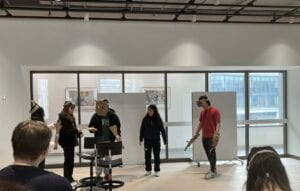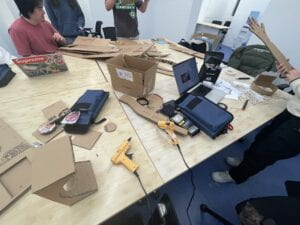Our artifact: the Mind-reading VR + tactile simulation glove

Concept of the artifact:
The simplified version of the nursery! It can read users’ minds through sensors and vividly present what they are thinking about. But the difference is our artifact is cheaper and easier to carry. And more importantly, it has tactile simulation gloves to enrich the experience. If technology can be advanced in the future, we will upgrade the gloves into a one-piece suit that completely fits the skin to achieve all-round real simulation, upgrade the VR into contact lenses for visual simulation so the user can hardly feel their existence, and reduce the mind-reading sensors into tiny pasters to stick on the user’s forehead.
Our story of performance:
The main character is a super lover of fur. One day, he went to an animal fur shop but was not satisfied with any furs. The shop owner happened to have the simplified version of the nursery– the mind-reading VR and the tactile simulation glove, so he recommended the main character try on it and “get” the fur by themselves. The main character wore them and thought about him on the veldt. He saw the tigers, lions, and dears, and started chasing and shooting them crazily. However, suddenly the VR lost control (probably some problem with the mind-reading system), and the main character found himself in a human meat shop. He was shocked to see that animals were trading fresh human legs and arms, and the shop owner was holding their head! The remaining reason told them that they should leave the world immediately. They hurriedly took off the VR and escaped the animal fur shop.
My role and teamwork:
I mainly focused on the concept of the artifact, the plot of the drama, and the production of the props. We had three group meetings. In the first and second meetings, we brainstormed and exchanged ideas about the artifact we want to make. We clarified the meaning of interactive and thought about the ways to make cardboard interactive without using electronics. One of my teammates raised an idea to make a helmet that can show different images, which brought up my idea of a mind-reading artifact to present what the user is thinking about and generate the five senses to make the experience vivid. At first, we were only thinking about making a shooting game to make it interactive. But we came up with the plot to make a huge reversal to exchange the positions of human beings and animals. In the third meeting, we draw the draft, made the props, wrote the script, and had the rehearsal. We split the works of cardboard making. I was responsible for researching and drawing the drafts of the cardboard, and I made the VR (with my teammate), human head, and animal headgear. I took the different ideas of the group and figure out the script, and one teammate record the script.




My opinion on the artifact:
I think the success of the artifact is that it gives people a warning. The most obvious theme of our artifact and performance is animal welfare. We want people to think about our relationship with animals and nature. We believe that we can not do everything we want to do, even though we seem to have the ability, and what we do to animals will fall on us someday.
The shop owner noticed that the main character “don’t stay too long in that world”, which is thought-provoking to me. His warning was realized: the VR “lost control”. I have two interpretations. 1) The mind-reading system has its own intelligence. From the data it collected, it develops its own moral standards and rule of society and applies them to its world. In its standard, some people are not qualified to be human beings. So it gives them punishment and changes their position. 2) There’s no intelligence in the mind-reading system. It sensitively tracks and strictly follows the thoughts of the user.
For the imperfect part of the artifact, I think the concept of the artifact itself is not very unique, but we have some envisioning and upgrading of it. Our improvement on the nursery in The Veldt is to simplify it and make it portable and unaware, so the user doesn’t need to go to the nursery to get the experience. To realize this concept and make it makeable with cardboard, we build on the existing VR technology. However, in terms of the technology we show in our performances, our improvement is not obvious except for the mind-reading function.
Our script:
MC goes to an animal shop and is not satisfied with what they find. A shopping assistant helps them out by providing a VR headset with an interactive glove, enhancing the experience, and informing the MC of the background of the products.
MC: I don’t like anything I see.
Shopping Assistant: Oh no, would you like to try this out? This is the latest version of VR with a glove. It can read your mind through the sensors, and let you vividly experience what you’re thinking about…
MC: Sure
MC Tries VR Headset, and imagines themselves as a hunter with a gun. The glove enhances the sensory experience, providing pre-programmed physical sensations. MC begins to hunt animals. Suddenly, the VR Headset begins to malfunction, altering the virtual world and making it so that animals have now begun having human markets.
Shop assistant of Human meat market: fresh human legs, arms and head on sale!
Animals buy meat from the shop assistant.
MC: [shocked and scared] AAAAAAAHHHHHH
MC takes off VR Headset
Shopping Assistant: Nice experience right? Buy one?
MC: I don’t have any money, sorry I have to leave
My analysis and assessment of the helmet which can control people’s minds:
The performance of the group is set in the background of the Plague. To protect themselves and survive, people who haven’t been infected with the virus are asked to kill those infected. However, it doesn’t make sense to sacrifice and decide other people’s life and death to save their own life. After the killing, the survivor started to feel guilty. To relieve their guilty, the main character lets them wear the helmet and put the idea “killing is saving” into their mind. The main character even uses the helmet to control the survivor’s mind and behavior to let them follow their instruction.
This artifact and performance are relevant to the fictional story The Plague. When realized that the people who turned to stone were still alive, the main character started to feel guilty and rethought the thing he did as a Crow. The mind control helmet can be applied in this situation in two ways: for the main character himself to relieve his guilty, and for the Emergency Management headquarters to give Crows instructions. I think it meets the criteria of the assignment, for it blends well in the universe of The Plague, and is interactive. I think the design of the device is a little bit unclear regarding how can the instructor input his instructions to the helmet. Their performance made it very clear about the usage and function of the artifact through a dramatized way, which helped me a lot in understanding the artifact.
Leave a Reply